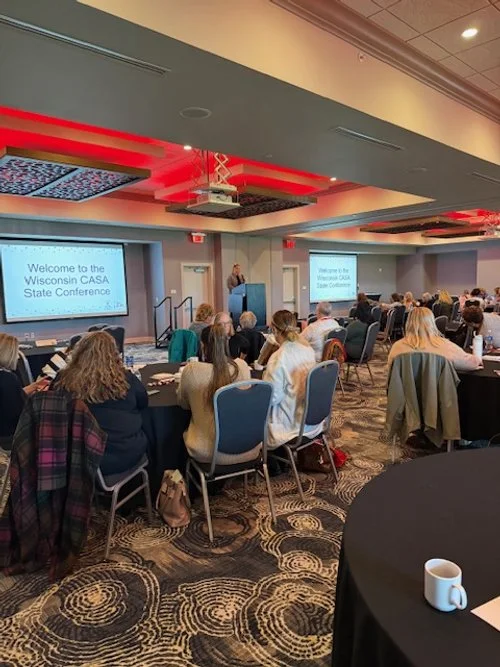
Latest News
Kentucky CASA Network Conference
Huge thanks to the Kentucky CASA Network for the work you do every day for children and families across the Commonwealth. Yesterday’s conference was energizing and inspiring and I enjoyed leading sessions on “Peer to Peer Learning: Lessons from the Field” and “Artificial Intelligence and Board Governance.” CASA volunteers change lives, and I highly encourage you to learn more about CASA programs near you.
#Nonprofit #Nonprofits #CASA #Speaker #Facilitator
BoardBuild Board Retreat
Enjoyed an energizing and impactful Board retreat with BoardBuild last week.
BoardBuild strengthens communities through the certification and matching of leaders with qualified nonprofit boards. BoardBuild equips individuals with the skills and knowledge they need to govern effectively — and helps organizations build stronger, more diverse, and more capable boards.
Grateful for the thoughtful conversations, the shared commitment, and the inspiring vision this board brings to the table.
Here’s to building stronger leaders and stronger communities.
#Nonprofit #Nonprofits #BoardBuild #BoardGovernance #Leadership #Community
Executive Search: Woody Williams Foundation - President and CEO
I am pleased to share an exciting leadership opportunity with the Woody Williams Foundation, a national organization dedicated to honoring, recognizing, and serving Gold Star Families and the legacy of their Loved Ones who made the ultimate sacrifice.
The Foundation is seeking a President & Chief Executive Officer to serve as its next leader. This individual will serve as the chief ambassador of the organization—advancing its mission, leading strategic growth and fundraising, and ensuring the sustainability of its programs that carry forward the vision of Hershel “Woody” Williams.
The Foundation is seeking a mission-driven, results-oriented leader who can strengthen operations, build relationships with stakeholders, and position the organization for long-term success.
I invite you to review the full position announcement.
If you or someone in your network might be a strong fit for this meaningful opportunity, please encourage them to submit a resume and cover letter to gregory@nielsenconsults.com. Applications will be reviewed on a rolling basis until the position is filled.
Thank you for helping us share this important opportunity to honor and serve Gold Star Families.
CASA Wisconsin Conference
Had a great time speaking at the annual CASA Wisconsin Conference. It was a privilege to lead a session entitled “Rowing Together: Board and Executive Director Partnerships” — exploring how strong collaboration and shared purpose between boards and executives drive mission impact.
Grateful for the inspiring work CASA programs do every day to advocate for children and families across Wisconsin, and for the thoughtful engagement of all who joined the discussion! 🚣♂️💙
#NonprofitLeadership #BoardGovernance #CASAWisconsin #LeadershipDevelopment #GregoryNielsen #NonprofitExcellence #CASA #Nonprofit #Nonprofits #Facilitator #Facilitation #ConferenceSpeaker
Board Champions 201 in Evansville
Excited to be in Evansville, Indiana yesterday facilitating Board Champions 201 with an incredible group of nonprofit leaders and board members!
This session builds on the foundations of strong governance and explores how boards can elevate their impact through strategic leadership, partnership, and accountability.
A heartfelt thank-you to the Welborn Baptist Foundation for their generosity and partnership in making this learning opportunity possible. Their commitment to strengthening nonprofit leadership in the region is truly inspiring.
#NonprofitLeadership #BoardGovernance #BoardDevelopment #Evansville #WelbornBaptistFoundation #LeadershipDevelopment
Finding the Right Leader: A Thoughtful Approach to Executive Search
Hiring a new CEO or Executive Director is one of the most important decisions a board will ever make. The right leader can help your organization flourish, while the wrong fit can set you back significantly. That’s why a structured, intentional process matters so much in executive search.
Too often, boards want to jump straight to looking at résumés. But the truth is, success starts well before candidates enter the picture. A strong search process isn’t just about finding a person—it’s about aligning leadership needs, organizational culture, and future vision. Our proven three-phase approach is based on the model developed by Gary Romano in Lean Recruitment: Finding Better Talent Faster -- a model that has been used worldwide.
Phase 1: DEFINE – Establishing the Foundation
Every successful search begins with clarity. Before you even write a job description, the board needs to step back and ask: What kind of leader do we need for where we are—and where we’re going?
This stage is all about building that foundation. The search committee meets with key stakeholders—board members, staff, community partners—to really understand organizational goals and leadership competencies. From these conversations comes a Position Announcement: a clear picture of the qualifications, skills, and characteristics you’re seeking in the next leader.
Equally important is developing a candidate scorecard. This tool allows the search committee to evaluate applicants consistently and fairly, avoiding bias and ensuring everyone is measured against the same criteria.
Another critical step is transparency. A search process only works when everyone knows their role and how communication will flow. Establishing a timeline, roles, and protocols at the beginning creates trust and reduces confusion. Boards also need to think carefully about the role of the outgoing executive—how and when they’ll be involved, and how to manage the transition respectfully.
Finally, don’t underestimate communication. Creating a plan to keep staff, board, and key partners appropriately informed avoids rumors and builds confidence in the process.
By the end of this phase, you have more than a job posting—you have a roadmap for a successful search.
Phase 2: DISCOVER – Sourcing and Screening Talent
Once the foundation is set, the real search begins. But here’s the key: don’t just wait for résumés to roll in. The best nonprofit leaders often aren’t actively job-hunting, so sourcing requires intentional outreach. That might mean tapping networks, connecting with affinity groups to ensure diversity, and working with your staff and board to identify promising candidates.
Structured interviews are a big part of this phase. Rather than each committee member “winging it,” a candidate interview guide helps ensure that every applicant is asked consistent, mission-aligned questions. This not only creates a fairer process but also makes it easier to compare candidates.
As the pool narrows, the search committee receives a shortlist of finalists, complete with summarized assessments. At this point, reference checks, academic verification, and even a scan of social media presence help confirm that what you see on paper matches reality.
This phase is where the committee starts to see real possibilities—and where the groundwork from Phase 1 pays off. Because you already know what you’re looking for, you can better recognize it when you see it.
Phase 3: DECIDE – Selecting and Supporting the New CEO
The final stage is about more than making a decision—it’s about making the right decision and setting your new leader up for success.
The board’s role is to weigh the evidence, conduct thoughtful finalist interviews, and ultimately come to consensus on the candidate who best aligns with the leadership profile and organizational vision. This isn’t just about who looks good on paper—it’s about who fits your culture and can help carry your mission forward.
Once the offer is made, the search doesn’t end. Supporting the transition is just as important as the hiring decision. A thoughtful onboarding plan, clarity around board-staff roles, and regular check-ins during the first year all help ensure your new executive feels supported and can hit the ground running.
Why We Rely on This Approach
By taking the time to define, discover, and decide, boards not only find the right leader but also build confidence among staff, stakeholders, and the community.
Hiring a nonprofit CEO is about more than filling a position. It’s about choosing the person who will inspire, guide, and steward your mission into the future. And that deserves nothing less than a thoughtful, intentional process.
Nonprofit Impact Summits: Gather for Growth
One of the most valuable things we can do as nonprofit leaders is to share what we’ve learned, our wins, our struggles, and the strategies that help us move forward. That’s why I’m honored to be part of the Nonprofit Impact Summits: Gather for Growth, where I’ll be presenting a session on Leading Through Uncertainty: Scenario Planning.
This summit gathers 70+ speakers who are passionate about strengthening the sector. From fundraising and marketing to leadership and operations, every session is designed to help organizations build capacity and drive greater impact.
If you’ve been looking for fresh ideas, inspiration, and practical tools to take your nonprofit to the next level, this is the place to be.
Join me HERE.
I’d love to see you in my session and hear how you’re creating change in your community.
#NonprofitImpact #Nonprofit #Nonprofits #Facilitator #Facilitation #ConferenceSpeaker #NonprofitLeadership #CapacityBuilding #Changemakers
Maryland Nonprofits Conference 2025
🌟 Excited to share that I presented “Weathering the What-Ifs: Scenario Planning for Resilience” at the Maryland Nonprofits Conference!
Scenario planning is a vital tool for nonprofits, helping organizations anticipate challenges, make informed decisions, and strengthen long-term resilience. 💡
CASA of Lexington Board Retreat
Honored to facilitate a Board retreat with the dedicated Board of Directors of CASA of Lexington. Grateful for their commitment to advocating for children and strengthening the organization’s impact in the community. Inspiring to see leaders come together with such passion and purpose! 💙
📢 Alley Cat Advocates Seeking Its Next Executive Director
Nielsen Training and Consulting is honored to partner with Alley Cat Advocates (ACA) in the search for its next Executive Director.
Since 1999, ACA has been led by its visionary co-founder and nationally recognized leader Karen Little. ACA is a trusted leader in the humane treatment of unowned cats through its nationally recognized Trap-Neuter-Return program.
The Board of Directors has launched a thoughtful and inclusive process to identify the organization’s next leader. The Executive Director will serve as the chief executive of ACA, reporting to the Board of Directors and leading a talented staff team. This is an opportunity to partner with a dedicated board, volunteers, donors, and community stakeholders to advance ACA’s mission and ensure its long-term sustainability.
During this transition, ACA remains strong, stable, and mission-focused—continuing to serve thousands of cats and community members each year with compassion and innovation. This moment presents an exciting opportunity for a new leader to honor ACA’s legacy while guiding it toward future growth and expanded impact.
The search will attract outstanding candidates who share ACA’s vision and values, bringing energy and leadership to this remarkable organization. You may view the full Executive Director Position Announcement for details about the role, desired qualifications, and application instructions.
Interested candidates should submit a cover letter and resume to gregory@nielsenconsults.com. Applications will be reviewed on a rolling basis, with preference given to submissions received by October 31, 2025.
I invite you to partner with us by sharing the linked position announcement with your networks. Your help spreading the word will ensure that we reach outstanding candidates excited to build on the success of Alley Cat Advocates.
Join Me at the Maryland Nonprofits Conference October 9
I’m thrilled to share that I’ll be speaking at the Maryland Nonprofits 2025 Annual Conference, “Facing the Future Together,” on October 8 and 9, hosted in collaboration with the Comptroller of Maryland.
Join me for my session: Weathering the What-Ifs: Scenario Planning for Resilience
Register for #MANOAC25 using the link below and be sure to use the link FRIEND10 to receive 10% off your conference registration.
Welcoming Dave Neumann to the NTC Team
We are delighted to announce that Dave Neumann is joining the NTC team as an Organizational Development Consultant. Dave has been a friend and trusted colleague for years and his passion for helping leaders and organizations thrive aligns with our mission.
Dave brings over 40 years of experience helping organizations achieve breakthrough results in both for-profit and nonprofit sectors. He holds a PhD in Industrial & Organizational Psychology and built a distinguished career in HR and OD leadership, including 22 years with PepsiCo and Yum Brands. There, he served as Vice President of Organization Development and as Chief Human Resources Officer for KFC, Long John Silver’s, and A&W Restaurants.
Since 2012, Dave has advised national and regional organizations in healthcare, manufacturing, and the nonprofit sector, with expertise in:
Organization Alignment – Connecting strategy, structure, resources, and culture for maximum impact.
Culture Development – Designing and embedding high-impact organizational values.
Organizational Effectiveness & Change – Improving executive performance, team alignment, employee engagement, and change readiness.
Human Resources Strategy – Guiding performance management, succession planning, and leadership development.
In Dave’s own words:
“I’m thrilled to be joining Nielsen Training & Consulting as an Organizational Development consultant. Having worked with Greg for many years, I know his deep competence, integrity, and gift for helping organizations and their boards to thrive. With over 40 years of experience in both for-profit and nonprofit organizations, I specialize in creating organizational effectiveness, aligning strategy, structure, and culture, strategic planning, teambuilding, and leadership development coaching. I’m excited to partner with Greg to help organizations achieve their mission, engage their staff, and make a lasting impact in the communities they serve.”
A client’s perspective:
As Executive Director of Dare to Care Food Bank, one of my first decisions was to engage Dave to develop a new strategic plan, as well as create and institute a new organizational structure and performance review process. Dave took complete ownership of the process, working closely with me, key staff, board members and stakeholders to accomplish this work in both a timely and professional manner. That strategic plan and org/performance review process set Dare to Care on an amazing growth arc for over a decade.
Brian Riendeau, Executive Director Dare to Care, Retired
“I had the privilege of working with Dave to develop our organizational values and design an experiential training to cascade them across the company. His ability to translate our vision into an engaging, hands-on experience was remarkable, and over a year later, we’re still living these values every day. His insight, creativity, and passion left a lasting mark on our culture.”
Kila Sweeney, Chief People Officer, Ovation Healthcare
"I’ve had the privilege of working with Dave Neumann at two different companies, each time bringing him in to help us navigate culture transformation. Dave’s process is thoughtful, his analysis is spot-on, and his wisdom runs deep. His experience working with executive leadership was instrumental in helping us gain full buy-in from our leadership teams, ensuring our culture strategy had the support it needed from the top down. Dave has a way of turning “culture” from a concept into something real and actionable, which helped us roll it out in a way that truly connected with our people and made a measurable impact on engagement. On top of all that, Dave is just fantastic to work with—kind, collaborative, and one of the most impressive humans you’ll ever meet."
Dr, Jennifer Platt, VP Organizational & People Development, Lifepoint Health
Please join us in welcoming Dave to the NTC team. We’re excited about the expertise, insight, and passion he brings to our clients and the communities they serve. Whether your needs involve strategy, governance, or organizational development, you can explore how partnering with NTC can elevate your team by clicking the link below to learn more.
NTCA Summer Symposium
Scenario planning helps boards anticipate change, navigate uncertainty, and make more resilient, forward-looking decisions. Had the pleasure of leading a session on Scenario Planning: Leading Through Uncertainty at the NTCA Summer Symposium! Grateful for the opportunity to engage with leaders focused on navigating change and building resilient strategies for the future
PRTC/CDG Board Retreat
Just wrapped up a dynamic and engaging Board retreat in beautiful Hilton Head Island, South Carolina with the dedicated Board members of Palmetto Rural Telephone Cooperative - PRTC and CDG. It was a privilege to facilitate conversations centered on strategy, governance, and future growth. Grateful for their commitment to thoughtful leadership and impactful service!
Team Retreat: Direct Employers Association and Recruit Rooster
Just wrapped up a powerful 2-day session on Successfully Managing People with the leadership teams of DirectEmployers Association and Recruit Rooster! Grateful for the opportunity to support such thoughtful, mission-driven leaders as they invest in growing their teams, strengthening culture, and leading with intention.
AI for Nonprofit Boards: Navigating the Future with Purpose
Artificial Intelligence. For some, it still feels like a distant sci-fi concept. For others, it’s already part of daily life —guiding our Netflix picks, routing our GPS, or even helping us write emails. But for nonprofit boards, AI might seem like unfamiliar territory. The truth? It’s not just relevant—it’s essential.
AI is no longer the future; it’s the now. And while it can feel intimidating, it offers incredible opportunities for nonprofits to better serve their missions, operate more efficiently, and make smarter decisions. The key is understanding how to navigate this new landscape with intention and integrity.
Let’s explore what that looks like.
Why Should Nonprofit Boards Care About AI?
Boards are charged with big-picture thinking: strategy, oversight, and ensuring the mission stays front and center. That’s exactly why AI belongs on your radar. It’s not just a technology tool—it’s a strategic lever.
Think about the challenges facing nonprofits today: limited resources, growing demand, the need for data-driven impact, and evolving donor expectations. AI can help address all of these. From automating administrative tasks and analyzing donor data, to improving program delivery and forecasting trends, AI offers practical benefits that align with organizational goals.
But just because we can use AI doesn’t always mean we should. That’s where thoughtful governance comes in.
Common Uses of AI in the Nonprofit Sector
Let’s break it down with some real-world examples of how nonprofits are using AI:
Donor engagement: AI can analyze donor behavior and personalize outreach—sending the right message to the right person at the right time.
Grant writing: Some organizations are using AI tools to generate drafts or gather background research more efficiently.
Chatbots: These can answer frequently asked questions, freeing up staff time and improving responsiveness.
Data analysis: AI can quickly sift through years of program data to identify patterns, outcomes, or service gaps.
Volunteer matching: AI tools can help match volunteer skills and preferences to specific organizational needs.
These aren’t just tech gimmicks—they’re mission-enhancing tools when used responsibly.
The Role of the Board in AI Strategy
So, where does the board fit in?
Your job isn’t to become tech experts. It’s to ask smart questions, ensure ethical use, and align technology decisions with your mission and values. Here are some guiding questions boards should be asking:
How does this AI tool help us advance our mission?
What data will it use, and how is that data being protected?
Could this technology create unintended bias or harm?
Are we transparent with our stakeholders about our use of AI?
What guardrails are in place to ensure ethical use?
Just like any major strategic decision, AI adoption needs to be vetted for its impact—on people, privacy, equity, and mission.
Ethical Considerations Matter
AI is powerful, but it’s not perfect. It reflects the data it’s trained on, and if that data includes bias, the results can be skewed—sometimes in ways that harm marginalized communities. That’s a serious concern for mission-driven organizations.
Nonprofit boards have a responsibility to uphold values of equity, accountability, and transparency. That means pushing for clear policies on how AI tools are selected and used, especially when they affect people’s access to services, opportunities, or support.
Being proactive here is key. Don't wait for a problem to arise—start the conversation now.
Getting Started: A Few Practical Tips
You don’t need a tech background to start leading with confidence on AI. Here’s how your board can begin:
Educate yourself – Bring in a speaker, take a webinar, or read up on nonprofit use cases. Knowledge is power.
Start small – Identify one area where AI could help. Maybe it's donor outreach or internal reporting.
Include AI in strategic planning – This ensures it’s part of the big-picture vision and not just a shiny add-on.
Appoint a “tech liaison” on the board – Someone who can track trends and bring updates to the board regularly.
Review your policies – Ensure data privacy, ethical use, and equity are baked into your tech decision-making.
Navigating with Purpose
At the end of the day, AI is just a tool. It can’t replace human compassion, creativity, or community connection. But it canhelp nonprofits scale their impact when guided by thoughtful leadership.
That’s where you come in.
As a board member, you are the stewards of your organization’s future. Embracing AI doesn’t mean abandoning your values—it means using every resource available to advance them more effectively.
So ask the hard questions. Stay curious. Lead with purpose.
Because the future isn’t just coming—it’s already here. And nonprofits have a powerful opportunity to shape it for good. If your Board or leadership team would like to learn more or explore this topic, let's connect!
Walden School Board Retreat
Healthy Boards not only plan for the present, they explore possibilities for the future with curiosity. It was a pleasure to facilitate a long-range planning retreat with the dedicated Board of Directors of Walden School, an independent K-12 school in Louisville, KY. Thoughtful, mission-driven leadership like theirs is the foundation of lasting impact. Grateful for the opportunity to support their commitment to excellence and innovation in education! 🌟📚
Finding Your North Star Through Strategic Planning with CASA State Directors
Had the privilege of presenting a session on best practices in strategic planning for the dedicated CASA state directors from across the country. We explored how to find your North Star through intentional, mission-driven planning—and how strategic clarity can guide powerful impact for children and families. Grateful for the important work these leaders do every day and special thanks to Kentucky CASA Network for the invitation!
Alley Cat Advocates Strategic Planning Retreat
Alley Cat Advocates (ACA) provides for the humane treatment of unowned cats in the metropolitan Louisville, Kentucky area. They performed 6,886 Spay/Neuter Surgeries in 2024, in addition to the quality and compassionate care they provide daily for community cats. It was a joy to facilitate a strategic planning retreat with their Board and staff team. I am grateful for the opportunity to support their vision and help shape the future of this impactful organization. 🐱💙
Foundation for Louisiana Students Board Retreat
🧠✨ I had the privilege of facilitating a Board retreat with the dedicated leaders of the Foundation for Louisiana Students.
We explored the timely topic of Artificial Intelligence for Nonprofit Boards and took a deep dive into the Habits and Practices of Healthy Boards. It was an energizing and thoughtful session focused on innovation, good governance, and impactful leadership.
Grateful for the opportunity to support this outstanding Board in their continued growth and service to students across Louisiana!





















